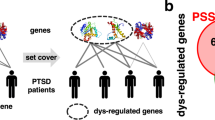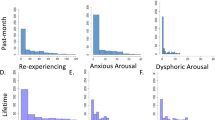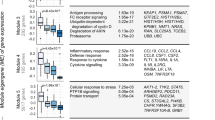Abstract
Trauma survivors show marked differences in the severity and persistence of post-traumatic stress disorder (PTSD) symptoms. Early symptoms subside in most, but persist as acute and chronic PTSD in a significant minority. The underlying molecular mechanisms or outcome predictors determining these differences are not known. Molecular markers for identifying any mental disorder are currently lacking. Gene expression profiling during the triggering and development of PTSD may be informative of its onset and course. We used oligonucleotide microarrays to measure peripheral blood mononuclear cell (PBMC) gene expression of trauma survivors at the emergency room and 4 months later. Gene expression signatures at both time points distinguished survivors who met DSM-IV diagnostic criteria for PTSD at 1 and 4 months, from those who met no PTSD criterion. Expression signatures at both time points correlated with the severity of each of the three PTSD symptom clusters assessed 4 months following exposure among all survivors. Results demonstrate a general reduction in PBMCs’ expression of transcription activators among psychologically affected trauma survivors. Several differentiating genes were previously described as having a role in stress response. These findings provide initial evidence that peripheral gene expression signatures following trauma identify an evolving neuropsychiatric disorder and are informative of its key clinical features and outcome. Replications in larger samples, as well as studies focusing on specific markers within the signatures discovered, are warranted to confirm and extend the diagnostic utility and pathogenetic implications of our results.
This is a preview of subscription content, access via your institution
Access options
Subscribe to this journal
Receive 12 print issues and online access
$259.00 per year
only $21.58 per issue
Buy this article
- Purchase on Springer Link
- Instant access to full article PDF
Prices may be subject to local taxes which are calculated during checkout





Similar content being viewed by others
References
American Psychiatric Association. Diagnostic and Statistical Manual of Mental Disorders, Fourth Edition. American Psychiatric Association: Washington, DC, 1994.
Breslau N . The epidemiology of posttraumatic stress disorder: what is the extent of the problem? J Clin Psychiatry 2001; 62: 16–22.
Kessler RC, Sonega A, Bromet E, Hughes M, Nelson CB . Posttraumatic stress disorder in the national comorbidity survey. Arch Gen Psychiatry 1995; 52: 1048–1060.
Yehuda R . Post-traumatic stress disorder. N Engl J Med 2002; 346: 108–114.
Rothbaum BO, Foa EB . Subtypes of posttraumatic stress disorder and duration of symptoms. In: Davidson JRT, Foa EB (eds). Posttraumatic Stress Disorder, DSM IV and Beyond. American Psychiatric Press: Washington, DC, 1993 pp 23–35.
Shalev AY, Freedman S, Peri T, Brandes D, Sahar T . Predicting PTSD in civilian trauma survivors: prospective evaluation of self report and clinician administered instruments. Br J Psychiatry 1997; 170: 558–564.
True WR, Rice J, Eisen SA, Heath AC, Goldberg J, Lyons MJ et al. A twin study of genetic and environmental contributions to liability for posttraumatic stress symptoms. Arch Gen Psychiatry 1993; 50: 257–264.
Shalev AY, Freedman S, Peri T, Brandes D, Sahar T, Orr SP et al. Prospective study of posttraumatic stress disorder and depression following trauma. Am J Psychiatry 1998; 155: 630–637.
Zlotnick C, Warshaw M, Shea MT, Allsworth J, Pearlstein T, Keller MB . Chronicity in posttraumatic stress disorder (PTSD) and predictors of course of comorbid PTSD in patients with anxiety disorders. J Trauma Stress 1999; 12: 89–100.
Blanchard EB, Hickling EJ, Forneris CA, Taylor AE, Buckley TC, Loos WR et al. Prediction of remission of acute posttraumatic stress disorder in motor vehicle accident victims. J Trauma Stress 1997; 10: 215–234.
Bryant RA, Sackville T, Dang ST, Moulds M, Guthrie R . Treating acute stress disorder: an evaluation of cognitive behaviour therapy and supportive counseling techniques. Am J Psychiatry 1999; 156: 1780–1786.
Brewin C, Andrews B, Valentine J . Meta-analysis of risk factors for posttraumatic stress disorder in trauma exposed adults. J Consult Clin Psychol 2000; 68: 748–766.
Freedman SA, Peri T, Brandes D, Shalev AY . Predictors of chronic PTSD—a prospective study. Br J Psychiatry 1999; 174: 353–359.
Pitman RK, Shalev AY, Orr SP . Post-traumatic stress disorder, emotion, conditioning and memory. In: Gazzaniga MS (ed). The Cognitive Neurosciences, 2nd edn 2000 pp 1133–1148.
Kaufer D, Friedman A, Seidman S, Soreq H . Acute stress facilitates long-lasting changes in cholinergic gene expression. Nature 1998; 393: 373–377.
Liberzon I, Lopez JF, Flagel SB, Vazquez DM, Young EA . Differential regulation of hippocampal glucocorticoid receptors mRNA and fast feedback: relevance to post-traumatic stress disorder. J Neuroendocrinol 1999; 11: 11–17.
Fujikawa T, Soya H, Fukuoka H, Alam KS, Yoshizato H, McEwen BS et al. A biphasic regulation of receptor mRNA expressions for growth hormone, glucocorticoid and mineralocorticoid in the rat dentate gyrus during acute stress. Brain Res 2000; 874: 186–193.
Aloe L, Bracci-Laudiero L, Alleva E, Lambiase A, Micera A, Tirassa P . Emotional stress induced by parachute jumping enhances blood nerve growth factor levels and the distribution of nerve growth factor receptors in lymphocytes. Proc Natl Acad Sci USA 1994; 91: 10440–10444.
Kawamura N, Kim Y, Asukai N . Suppression of cellular immunity in men with a past history of posttraumatic stress disorder. Am J Psychiatry 2001; 158: 484–486.
Miller RJ, Sutherland AG, Hutchison JD, Alexander DA . C-reactive protein and interleukin 6 receptor in post-traumatic stress disorder: a pilot study. Cytokine 2001; 13: 253–255.
Spivak B, Shohat B, Mester R, Avraham S, Gil-Ad I, Bleich A et al. Elevated levels of serum interleukin-1 beta in combat-related posttraumatic stress disorder. Biol Psychiatry 1997; 42: 345–348.
Maes M, Lin AH, Delmeire L, Van Gastel A, Kenis G, De Jongh R et al. Elevated serum interleukin-6 (IL-6) and IL-6 receptor concentrations in posttraumatic stress disorder following accidental man-made traumatic events. Biol Psychiatry 1999; 45: 833–839.
Achiron A, Gurevich M, Friedman N, Kaminski N, Mandel M . Blood transcriptional signatures of multiple sclerosis: unique gene expression of disease activity. Ann Neurol 2004; 55: 410–417.
Tang Y, Lu A, Aronow BJ, Sharp FR . Blood genomic responses differ after stroke, seizures, hypoglycemia, and hypoxia: blood genomic fingerprints of disease. Ann Neurol 2001; 50: 699–707.
Li C, Wong WH . Model-based analysis of oligonucleotide arrays: Expression index computation and outlier detection. Proc Natl Acad Sci USA 2001; 98: 31–36.
Kaminski N, Friedman N . Practical approaches to analyzing results of microarray experiments. Am J Respir Cell Mol Biol 2002; 27: 125–132.
Ben-Dor A, Friedman N, Yakhini Z . Overabundance Analysis and Class Discovery in Gene Expression Data, Technical Report 2002–50, School of Computer Science & Engineering, Hebrew University, 2002.
Eisen MB, Spellman PT, Brown PO, Botstein D . Cluster analysis and display of genome-wide expression patterns. Proc Natl Acad Sci USA 1998; 95: 14863–14868.
Nisenbaum LK . The ultimate chip shot: can microarray technology deliver for neuroscience? Genes Brain Behav 2002; 1: 27–34.
Barlow C, Lockhart DJ . DNA arrays and neurobiology—what's new and what's next? Curr Opin Neurobiol 2002; 12: 554–561.
McEwen BS . Protective and damaging effects of stress mediators. N Engl J Med 1998; 338: 171–179.
Southwick SM, Bremner JD, Rasmusson A, Morgan III CA, Arnsten A, Charney DS . Role of norepinephrine in the pathophysiology and treatment of posttraumatic stress disorder. Biol Psychiatry 1999; 46: 1192–1204.
Chrousos GP . The hypothalamic-pituitary-adrenal axis and immune-mediated inflammation. N Engl J Med 1995; 332: 1351–1362.
Andreasen NC . Linking mind and brain in the study of mental illnesses: a project for a scientific psychopathology. Science 1997; 275: 1586–1593.
Radant A, Tsuang D, Peskind ER, McFall M, Raskind W . Biological markers and diagnostic accuracy in the genetics of posttraumatic stress disorder. Psychiatry Res 2001; 102: 203–215.
van de Vijver MJ, He YD, van’t Veer LJ, Dai H, Hart AA, Voskuil DW et al. A gene-expression signature as a predictor of survival in breast cancer. N Engl J Med 2002; 347: 1999–2009.
Rosenwald A, Wright G, Chan WC, Connors JM, Campo E, Fisher RI et al. Lymphoma/Leukemia Molecular Profiling Project. The use of molecular profiling to predict survival after chemotherapy for diffuse large-B-cell lymphoma. N Engl J Med 2002; 346: 1937–1947.
Iwamoto K, Kakiuchi C, Bundo M, Ikeda K, Kato T . Molecular characterization of bipolar disorder by comparing gene expression profiles of postmortem brains of major mental disorders. Mol Psychiatry 2004; 9: 406–416.
Kakiuchi C, Iwamoto K, Ishiwata M, Bundo M, Kasahara T, Kusumi I et al. Impaired feedback regulation of XBP1 as a genetic risk factor for bipolar disorder. Nat Genet 2003; 35: 171–175.
Gilbertson MW, Shenton ME, Ciszewski A, Kasai K, Lasko NB, Orr SP et al. Smaller hippocampal volume predicts pathologic vulnerability to psychological trauma. Nat Neurosci 2002; 11: 1242–1247.
Kim JJ, Diamond DM . The stressed hippocampus, synaptic plasticity and lost memories. Nat Rev Neurosci 2002; 6: 453–462.
Schafe GE, Nader K, Blair HT, LeDoux JE . Memory consolidation of Pavlovian fear conditioning: a cellular and molecular perspective. Trends Neurosci 2001; 24: 540–546.
McEwen BS . Plasticity of the hippocampus: adaptation to chronic stress and allostatic load. Ann NY Acad Sci 2001; 933: 265–277.
Santarelli L, Saxe M, Gross C, Surget A, Battaglia F, Dulawa S et al. Requirement of hippocampal neurogenesis for the behavioral effects of antidepressants. Science 2003; 301: 805–809.
Manji HK, Drevets WC, Charney DS . The cellular neurobiology of depression. Nat Med 2001; 7: 541–547.
Acknowledgements
This work was supported by a Horowitz foundation grant from the Hadassah Hebrew University Medical Center – Hadassit Research and Development Division to RHS and AYS. NS and NF were supported in part by a German-Israeli Foundation (GIF) grant. NS was supported in part by the Sudarsky center for computational biology. NF was also supported by an Alon Fellowship and by the Harry and Abe Sherman Senior Lectureship in Computer Science. AYS was supported in part by a PHS Research Grant No. MH50379. NK is the Dorothy P and Richards P Simmons Chair for Interstitial Lung Diseases in the University of Pittsburgh. We thank Nelly Glusman and Jasmine Jacob-Hirsch, staff of the Functional Genomics Unit, The Chaim Sheba Medical Center, Israel, for their help in the preparation of samples and hybridization; to Yair Banet, Neta Bargai, Ruth Boker, Sara Freedman and Rivka Tuval of the Center for Traumatic Stress at Hadassah University Hospital for recruitment and clinical assessments; to Laura Canetti of the Department of Psychiatry at Hadassah University Hospital for help in statistical analyses; and to Derek Angus, Michael Donahoe, Laura Garwin, Aviv Regev and Zohar Yakhini for helpful comments during manuscript preparation. We are named inventors on a patent to use gene expression technology to ascertain PTSD prognosis.
Author information
Authors and Affiliations
Corresponding authors
Additional information
Supplementary Information accompanies the paper on Molecular Psychiatry website (http://www.nature.com/mp)
Supplementary information
Rights and permissions
About this article
Cite this article
Segman, R., Shefi, N., Goltser-Dubner, T. et al. Peripheral blood mononuclear cell gene expression profiles identify emergent post-traumatic stress disorder among trauma survivors. Mol Psychiatry 10, 500–513 (2005). https://doi.org/10.1038/sj.mp.4001636
Received:
Revised:
Accepted:
Published:
Issue Date:
DOI: https://doi.org/10.1038/sj.mp.4001636
Keywords
This article is cited by
-
Discovery and replication of blood-based proteomic signature of PTSD in 9/11 responders
Translational Psychiatry (2023)
-
Metabolomics analysis of post-traumatic stress disorder symptoms in World Trade Center responders
Translational Psychiatry (2022)
-
Long non-coding RNA LINC00926 regulates WNT10B signaling pathway thereby altering inflammatory gene expression in PTSD
Translational Psychiatry (2022)
-
Inhibition of FKBP51 induces stress resilience and alters hippocampal neurogenesis
Molecular Psychiatry (2022)
-
Altered gene expression and PTSD symptom dimensions in World Trade Center responders
Molecular Psychiatry (2022)



